Toyota Camry cars in 1993 underwent another upgrade, and in the next year a new generation of V40 with improved features was put into production. V30 trucks were sold only in Japan, and for other markets XV10 body with larger dimensions was offered.
A brief description of the 1993 Toyota Camry
The V30 was offered to customers with four-door sedan and hardtop bodies (for which a separate designation, the Camry Prominent, was used). At the same time, there was a Scepter model on the Japanese domestic market, which since 1993 was exported under the name Camry. Over the next few years, Toyota had two Camry models in its production lineup (for domestic and foreign markets), which differed in appearance, body dimensions, displacement and engine power.
Over the next few years, Toyota had two Camry models in its production lineup (for domestic and foreign markets), which differed in appearance, body dimensions, displacement and engine power.
Equipment and technical characteristics of the car
Cars intended for the domestic market, traditionally differed by a rich starting package and a large set of additional options. The interior had fabric or velour upholstery, the driver's seat had continuously adjustable height. The front seats were equipped with soft headrests, which can be adjusted in two directions. The rear sofa had an integrated neck support and a padded armrest in the center. Storage drawers on the back of the center console and under-glass shelf are used to store small items.
The steering wheel was mounted on an angle-adjustable column, and additional mirrors were provided on the sun visors. Electric side window drives for front and rear doors were included as standard equipment. The driver could lock the mechanisms with a button on the door trim armrest. The instrument cluster with additional indicators was used to monitor the vehicle's operating parameters, while the more expensive versions offered a digital unit.
The cars were equipped with a welded body, which included a power frame to increase rigidity and safety in side or frontal accidents. The power unit was mounted transversely to the front, with front-wheel drive in the base model. The Four with rear-wheel drive was also available. The transmission consisted of a transfer case, driveshaft, and rear reduction gear, connected to the wheels by half-axles with joints. With all-wheel drive, the fuel tank volume was reduced due to the shaft notch in the reservoir.
The front suspension was fitted with standard McPherson struts, while the rear suspension was a three-lever system supplemented by struts and coil springs. The front and rear were equipped with anti-roll bars. Some trucks used shock absorbers with a control unit, which allowed to adjust the stiffness. Rack and pinion steering had a hydraulic booster, and expensive modifications had a mechanism for changing the position of the rear wheels (the system improves maneuverability).
The trucks were equipped with a 4-speed hydromechanical transmission with winter mode support. The base versions used a 5-speed gearbox with synchromesh on forward gears and dry clutch.
The main parameters of V30 cars:
wheelbase - 2600 mm;
Body length (depending on the type) - up to 4670 mm;
width (by door sides) - 1695 mm;
height - up to 1410 mm;
ground clearance - 150-155 mm;
capacity of the fuel tank - 60-65 liters;
Top speed - up to 180 km/h (forced limitation);
Saloon capacity - 5 people;
curb weight of the vehicle - up to 1380 kg;
allowable weight of the vehicle - up to 1880 kg.
Advantages and disadvantages
Advantages of the 1993 Toyota Camry:
spacious interior;
good ventilation and heating system;
easy repair and maintenance;
powerful engine and reliable automatic transmission;
gasoline engines that start in -30°C temperatures without additional preparation.
Disadvantages of the cars:
mileage of extant copies exceeding 500 thousand km;
Lack of original spare parts;
high fuel consumption;
Insufficient ground clearance;
Weak suspension, can not withstand driving on roads with poor pavement;
corrosion damage of body parts due to natural aging.
Interior and exterior
The body of the V30 generation had a reduced roof height and an elongated front end, visually elongated due to the plastic bumper. Headlights with standard incandescent bulbs were equipped with glass exterior elements. The curved turn signals were located in the corners of the bumper (there were no side repeaters on the fenders). A narrow grille with chrome edging was located between the headlights, and there was an additional air intake in the bumper. An angled windshield and rounded body edges helped to reduce aerodynamic drag and noise levels at speeds above 120 km/h. The mirrors were located in the corners of the front doors, and the exterior plastic elements were painted in body color by default. The factory offered several basic shades and metallic paint. Rear lighting consisted of side lamps and a central section with reversing indicators, located on the hinged lid of the luggage compartment.
An angled windshield and rounded body edges helped to reduce aerodynamic drag and noise levels at speeds above 120 km/h. The mirrors were located in the corners of the front doors, and the exterior plastic elements were painted in body color by default. The factory offered several basic shades and metallic paint. Rear lighting consisted of side lamps and a central section with reversing indicators, located on the hinged lid of the luggage compartment.
The interior of the car had a classic design with a massive dashboard with smooth contours, made of foam plastic and equipped with a steel power frame. The central portion of the panel flowed seamlessly into the console with a massive armrest. Under the cover, trimmed in cloth or velour to match the general style of the interior, was a storage box for small items. The door panels of soft plastic had decorative inserts, and there were pockets for storing bottles with drinks and maps.
Carpeting was used for the interior floor (the color of the material depended on the design of the seats), and plastic covers were used on the sills and uprights. The metal floor had a small overhang, which did not hamper the landing of the passenger in the middle part of the rear seat.
Engine
The plant used on the V30 several types of gasoline engines:  In-line 4S-FE, with a displacement of 4 cylinders of 1.8 liters and an output of 125 hp;
In-line 4S-FE, with a displacement of 4 cylinders of 1.8 liters and an output of 125 hp;
In-line 4-cylinder 3S-FE with a capacity of 2.0 liters and 135 hp;
1VZ-FE in-line 6-cylinder, 165 horsepower, 2.0 liters;
2.5-liter, 175-horsepower, 6-cylinder 4VZ-FE.
All gasoline engines were equipped with multi-point injection and four-valve timing with hydraulic clearance adjustment. Fuel was supplied by electronically controlled injectors, and the controller automatically regulated the ignition timing. The company offered a diesel version with 91-horsepower 2C-T engine (4 cylinders), equipped with a turbine.
Camry Safety
Camry V30s offered in 1993 were equipped with inertial seat belts for driver and passengers. The upper attachment points on the center pillars were height-adjustable. There was an airbag in the steering wheel, and head restraints protected the cervical vertebrae of the driver and front passenger from injury upon impact with the rear of the car. The base version had disc type brakes with two separate hydraulic circuits and ABS system which supported electronic force distribution.


-rear-and-front-view-camera-6.png)

